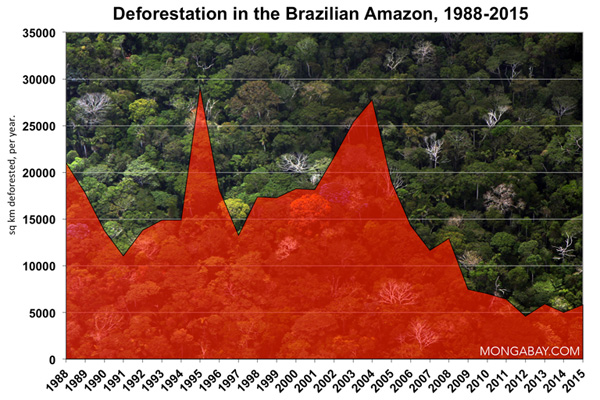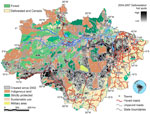
Mato Grosso, Brazil
A rural credit law that ties loans to environmental compliance made a significant contribution to reducing deforestation in the Brazilian Amazon between 2008 and 2011, argues a study published by the Climate Policy Initiative (CPI).
Does Credit Affect Deforestation? Evidence from a Rural Credit Policy in the Brazilian Amazon looks at the impact of Brazil’s Resolution 3545, a 2008 law that restricts access to subsidized credit for rural farmers and ranches who fail to provide proof of compliance with environmental laws. The study concludes that Resolution 3545 resulted in the withholding of 2.9 billion Brazilian reals ($1.4 billion) in rural credit between 2008 and 2011, preventing 2,700 square kilometers of deforestation. The area represents 15 percent of the decline in forest clearing observed during the period.
The impact was the strongest in areas where cattle ranching — by far the biggest direct driver of deforestation in the Brazilian Amazon — is the main economic activity, rather than production of crops like soy, maize, rice, and sugar cane. According to CPI, the finding “suggests that cattle ranchers are credit-constrained and responded more to changes in the availability of subsidized credit, or that crop farmers may use the subsidies to intensify productivity instead of expand their production frontier.”
The paper also found that “large producers were more affected than small producers, who had less stringent requirements and more exemptions.”

Juliano Assunção, director of CPI Rio and professor at the Department of Economics at the Pontifical Catholic University of Rio de Janeiro (PUC-Rio), says the results show that Brazil’s policy interventions are having a significant impact on reducing deforestation, which has fallen sharply since the government launched the Plano de Ação para a Prevenção e o Controle do Desmatamento na Amazônia Legal (PPCDAm) program to cut forest loss in 2004.
“It’s clear from our analysis that Brazil’s rural credit policy is helping to reduce deforestation,” Assunção said in a statement. “We also see, however, that design and implementation details matter.”
An earlier analysis by CPI estimated that about half the observed drop in Amazon deforestation could be attributed to government government conservation. Other factors behind the nearly 80 percent drop in the annual deforestation rate since 2004 include macro-economic factors, changing consumer preference, and private sector initiatives.
Brazil accounts for more than 60 percent of the Amazon and over 30 percent of the world’s tropical rainforest cover.
Juliano Assunção, Clarissa Gandour, Romero Rocha, and Rudi Rocha. Does Credit Affect Deforestation? Evidence from a Rural Credit Policy in the Brazilian Amazon. Climate Policy Initiative. January 2013
Related articles
Norway payments to Brazil for reducing deforestation reach $670 million
(12/06/2012) Norway will deposit another $180 million into Brazil’s Amazon Fund after the Latin American giant reported a third straight annual drop in deforestation, reports Bloomberg. The payment comes despite a high-profile dispute over who verifies reductions in emissions from deforestation — Norway believes emissions reductions should be measured by an independent third party, but Brazil disagrees. The disagreement sidelined discussions over the REDD+ mechanism during climate talks in Doha, pushing negotiations over the program out another year.
Government policy contributes to huge drop in Amazon deforestation in Brazil
(03/28/2012) Roughly half of the 70 percent decline in deforestation in the Brazilian Amazon between 2005 and 2009 can be attributed to policies enacted by the Brazilian government, finds an analysis published by the Climate Policy Initiative (CPI), a group funded by George Soros. The measures helped avoid 62,000 square kilometers of deforestation and 620 million tons of carbon dioxide emissions that would have otherwise occurred.
As Amazon deforestation falls, food production rises
(01/09/2012) A sharp drop in deforestation has been accompanied by an increase in food production in the Brazilian state of Mato Grosso, reports a new study published in the journal Proceedings of the National Academy of Science. The research argues that policy interventions, combined with pressure from environmental groups, have encouraged agricultural expansion in already-deforested areas, rather than driving new forest clearing.
Major Brazilian banks sued for loans linked to deforestation
(04/03/2011) Brazilian prosecutors have filed suit against the state-run Banco do Brasil and Banco da Amazonia for providing loans to companies that illegally cleared Amazon rainforest and used slave-like labor, reports Reuters.
New protected areas in Brazil contribute to major drop in Amazon deforestation rate

(06/01/2010) Protected areas in the Brazilian Amazon are proving highly effective in reducing forest loss in Earth’s largest rainforest, reports a new study based on analysis of deforestation trends in and around indigenous territories, parks, military holdings, and sustainable use reserves. The research, published in the early edition of Proceedings of the National Academy of Sciences, finds that 37 percent of the recent decline in deforestation in the Brazilian Amazon can be attributed to newly established protected areas. Brazil designated some 709,000 square kilometers (274,000 sq mi) of Amazon forest — an area larger than the state of Texas — between 2002 and 2009 under its Amazon Protected Areas Program (ARPA). Meanwhile deforestation in the Brazilian Amazon fell by nearly three-quarters between 2004 and 2009.